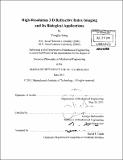| dc.contributor.advisor | George Barbastathis. | en_US |
| dc.contributor.author | Sung, Yongjin | en_US |
| dc.contributor.other | Massachusetts Institute of Technology. Dept. of Mechanical Engineering. | en_US |
| dc.date.accessioned | 2011-12-09T21:30:26Z | |
| dc.date.available | 2011-12-09T21:30:26Z | |
| dc.date.copyright | 2011 | en_US |
| dc.date.issued | 2011 | en_US |
| dc.identifier.uri | http://hdl.handle.net/1721.1/67600 | |
| dc.description | Thesis (Ph. D.)--Massachusetts Institute of Technology, Dept. of Mechanical Engineering, 2011. | en_US |
| dc.description | Cataloged from PDF version of thesis. | en_US |
| dc.description | Includes bibliographical references (p. 100-106). | en_US |
| dc.description.abstract | This thesis presents a theory of 3-D imaging in partially coherent light under a non-paraxial condition. The transmission cross-coefficient (TCC) has been used to characterize partially coherent imaging in a 2- D and 3-D paraxial model. It is shown that the 3-D TCC under the non-paraxial condition is an overlap integral of three hemispheres or 3-D pupil functions. By an inspection of the overlap integral, a simple formula is derived that can be efficiently calculated by multiple applications of the 3-D fast Fourier transform (FFT) instead of a 6-D integral. The theory is applied to phase contrast and differential interference contrast (DIC), and it provides the most rigorous 3-D model that has ever been suggested. Contrast-agent-free microscopy is highly desirable to study the dynamics and physiological activity of various structures in living cells. Refractive index is an intrinsic contrast source, but at the same time it is an important biochemical parameter that is proportional to the concentration of molecules. By measuring the refractive index quantitatively, the alteration of cells under chemicals or drugs as well as their normal physiological activities can be monitored in most native conditions. This thesis presents 3-D optical diffraction tomography (ODT) to retrieve the 3-D refractive index map of a transparent biological sample and applies them to some interesting biological problems: the study of cell growth and monitoring the effect of drugs on multiple myeloma cells. In most practical applications of ODT, the angular coverage of an incident beam is limited due to finite system numerical aperture. The refractive index map reconstructed from the restricted data set suffers from the missing cone artifact: elongation of the reconstructed shape along the optical axis and underestimation of the value of the refractive index. This thesis presents that the missing-cone artifact can be effectively suppressed by applying positivity and piecewise-smoothness constraints in the iterative reconstruction framework. By filling the missing cone, a 3-D refractive index map can be reconstructed from the scattering into the entire 4-[pi]nt solid angle. With the improved accuracy, we attempt to quantify the dry mass of chromosomes in single living cells in their mitotic phase. | en_US |
| dc.description.statementofresponsibility | by Yongjin Sung. | en_US |
| dc.format.extent | 100 p. | en_US |
| dc.language.iso | eng | en_US |
| dc.publisher | Massachusetts Institute of Technology | en_US |
| dc.rights | M.I.T. theses are protected by
copyright. They may be viewed from this source for any purpose, but
reproduction or distribution in any format is prohibited without written
permission. See provided URL for inquiries about permission. | en_US |
| dc.rights.uri | http://dspace.mit.edu/handle/1721.1/7582 | en_US |
| dc.subject | Mechanical Engineering. | en_US |
| dc.title | High-resolution 3-D refractive index imaging and Its biological applications | en_US |
| dc.title.alternative | High-resolution three-D refractive index imaging and Its biological applications | en_US |
| dc.title.alternative | High-resolution three-dimensional refractive index imaging and Its biological applications | en_US |
| dc.type | Thesis | en_US |
| dc.description.degree | Ph.D. | en_US |
| dc.contributor.department | Massachusetts Institute of Technology. Department of Mechanical Engineering | |
| dc.identifier.oclc | 764478678 | en_US |
